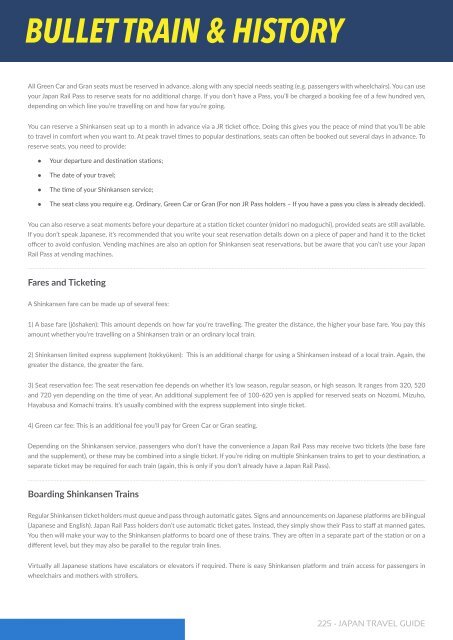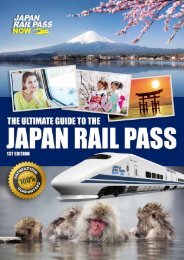Japan Rail Pass Now - Japan Travel Guide
Japan Travel Guide by Japan Rail Pass Now (www.japanrailpass.com.au)
Japan Travel Guide by Japan Rail Pass Now (www.japanrailpass.com.au)
You also want an ePaper? Increase the reach of your titles
YUMPU automatically turns print PDFs into web optimized ePapers that Google loves.
Bullet Train & History<br />
All Green Car and Gran seats must be reserved in advance, along with any special needs seating (e.g. passengers with wheelchairs). You can use<br />
your <strong>Japan</strong> <strong>Rail</strong> <strong>Pass</strong> to reserve seats for no additional charge. If you don’t have a <strong>Pass</strong>, you’ll be charged a booking fee of a few hundred yen,<br />
depending on which line you’re travelling on and how far you’re going.<br />
You can reserve a Shinkansen seat up to a month in advance via a JR ticket office. Doing this gives you the peace of mind that you’ll be able<br />
to travel in comfort when you want to. At peak travel times to popular destinations, seats can often be booked out several days in advance. To<br />
reserve seats, you need to provide:<br />
●<br />
●<br />
●<br />
●<br />
Your departure and destination stations;<br />
The date of your travel;<br />
The time of your Shinkansen service;<br />
The seat class you require e.g. Ordinary, Green Car or Gran (For non JR <strong>Pass</strong> holders – If you have a pass you class is already decided).<br />
You can also reserve a seat moments before your departure at a station ticket counter (midori no madoguchi), provided seats are still available.<br />
If you don’t speak <strong>Japan</strong>ese, it’s recommended that you write your seat reservation details down on a piece of paper and hand it to the ticket<br />
officer to avoid confusion. Vending machines are also an option for Shinkansen seat reservations, but be aware that you can’t use your <strong>Japan</strong><br />
<strong>Rail</strong> <strong>Pass</strong> at vending machines.<br />
Fares and Ticketing<br />
A Shinkansen fare can be made up of several fees:<br />
1) A base fare (jōshaken): This amount depends on how far you’re travelling. The greater the distance, the higher your base fare. You pay this<br />
amount whether you’re travelling on a Shinkansen train or an ordinary local train.<br />
2) Shinkansen limited express supplement (tokkyūken): This is an additional charge for using a Shinkansen instead of a local train. Again, the<br />
greater the distance, the greater the fare.<br />
3) Seat reservation fee: The seat reservation fee depends on whether it’s low season, regular season, or high season. It ranges from 320, 520<br />
and 720 yen depending on the time of year. An additional supplement fee of 100-620 yen is applied for reserved seats on Nozomi, Mizuho,<br />
Hayabusa and Komachi trains. It’s usually combined with the express supplement into single ticket.<br />
4) Green car fee: This is an additional fee you’ll pay for Green Car or Gran seating.<br />
Depending on the Shinkansen service, passengers who don’t have the convenience a <strong>Japan</strong> <strong>Rail</strong> <strong>Pass</strong> may receive two tickets (the base fare<br />
and the supplement), or these may be combined into a single ticket. If you’re riding on multiple Shinkansen trains to get to your destination, a<br />
separate ticket may be required for each train (again, this is only if you don’t already have a <strong>Japan</strong> <strong>Rail</strong> <strong>Pass</strong>).<br />
Boarding Shinkansen Trains<br />
Regular Shinkansen ticket holders must queue and pass through automatic gates. Signs and announcements on <strong>Japan</strong>ese platforms are bilingual<br />
(<strong>Japan</strong>ese and English). <strong>Japan</strong> <strong>Rail</strong> <strong>Pass</strong> holders don’t use automatic ticket gates. Instead, they simply show their <strong>Pass</strong> to staff at manned gates.<br />
You then will make your way to the Shinkansen platforms to board one of these trains. They are often in a separate part of the station or on a<br />
different level, but they may also be parallel to the regular train lines.<br />
Virtually all <strong>Japan</strong>ese stations have escalators or elevators if required. There is easy Shinkansen platform and train access for passengers in<br />
wheelchairs and mothers with strollers.<br />
225 - <strong>Japan</strong> <strong>Travel</strong> <strong>Guide</strong>



